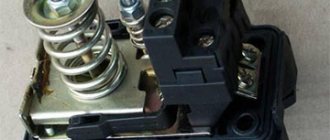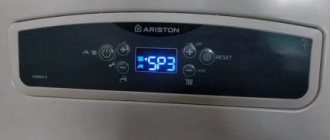The reasons why the automatic machine knocks out can be divided into three categories. The first reason is a defect in the machine itself, the second is something wrong with the load, and the third is problems in the controlled line. The solution to the problem of troubleshooting is to gradually localize sections of electrical wiring. The correct verification algorithm will significantly speed up and simplify the search.
Knocking out when putting electrical wiring into operation
In the case of new construction or major renovation of a home, new electrical wiring is laid and, accordingly, an electrical panel is installed with protection devices against leakage currents and short circuits.
After installing and turning on the machines, a malfunction appears. The difavtomat knocks out either immediately or after connecting the load.
In this case, a defect in the device itself is excluded, since it was checked upon purchase. The only thing you need to do is check the values of the breaking and rated current of the difavtomat.
They must correspond to the values previously calculated and indicated in the diagram. The second reason can be eliminated by replacing the load with a regular table lamp.
This is usually done on an already operating power supply system. When you turn on the electrical wiring for the first time, you need to start by checking the installation.
Checking the differential machine begins by turning on the device in test mode. If it works, it means it's working. The sequence of further actions is as follows:
- make sure the load is off;
- turn on the machine, if it is knocked out, it means that the conductors are connected incorrectly;
- make sure that the neutral wire is connected to the upper contacts marked N, and the phase wire is connected to contact L;
- check the lower contacts of the difavtomat for correct connection of the wires from the controlled line;
- try turning on the security device.
Pay attention to where the neutral wire comes from. It should go to the upper contact from the zero bus.
The neutral wire from the controlled line, coming from the distribution box, is connected to the bottom terminal. If it’s knocked out again, then you should check the connections in it itself.
Features of installation of individual difavtomats
This connection method involves the installation of several devices. Thus, a protective device is fixed to each outgoing line and energy-intensive consumers. In addition, an additional device is installed separately in front of the RCD group. It turns out that the first appliance is placed on the lamps, the second on the group of sockets, the third on the hob and oven.
Installation of individual devices by energy consumption groups
This method has obvious advantages, because it ensures complete protection of the system. In addition, if a malfunction occurs, it will be easy to detect the problematic line and repair it. Among the disadvantages, it should be noted that residents will have to spend a lot of money on the purchase of several differential circuit breakers, which are more expensive than conventional RCDs.
Connecting a differential circuit breaker in an electrical circuit without grounding
Years earlier, when constructing any objects, it was mandatory to have a grounding loop. Each distribution panel of an apartment building was connected to it. Now, during the construction of residential and non-residential premises, the presence of a ground loop is not always provided.
Note! Installation of differential circuit breakers is still required to ensure an optimal level of network protection. Moreover, the device in such a circuit not only prevents malfunctions, but also serves as a grounding element and prevents current leakage.
Checking in the distribution panel
The most common installation errors occur in the distribution box; neutral conductors from different lines are connected or connections are changed. This is the sin of electricians who are accustomed to working only with circuit breakers. For them, it does not matter which line the neutral wire came from, since they control the current on the phase wire.
This is important for differential circuit breakers and RCDs, since they react to the difference in currents in the phase and neutral wires of the controlled line.
After making sure that the installation in the junction box is correct, try turning on the automatic switch.
If the device turns off again, then you need to check how the wires running from the junction box to the outlet are connected. Here, too, the neutral and ground wires are often confused. If everything is normal here, then the automatic machine will turn on and take control.
For particularly distrustful people who want to check the functionality of the automatic machine, you can do the following. Using an indicator screwdriver, you need to find the zero in the socket and connect it to ground.
Since no currents flow through the neutral and phase wires without load, the automatic circuit breaker will not react in any way. When you turn on a load, even a 100 W desk lamp, the device will immediately turn off.
Since the current in the neutral wire will be two times less than in the phase wire (due to its partial passage through the ground conductor), a current difference will arise. And it will trigger the electromagnetic release of the automatic device.
What is a difavtomat and how does it function?
As we have already said, differential circuit breakers are necessary to protect the electrical network from unforeseen circumstances. Its work is to simultaneously turn off phase and zero. It turns out that the device monitors the presence of short circuits and current leakage. More precisely, this equipment is characterized by the following functions:
- monitoring of short circuit currents and instantaneous line shutdown;
- turning off the power when there is excessive load (when there is a danger of wiring melting).
Based on this, we can conclude that the difavtomat performs the functions of two devices - a circuit breaker and an RCD . Only here these devices are connected by a common housing.
The differential machine performs the functions of two devices, but at the same time takes up minimal space
Reasons for shutdown in a working electrical network
The reasons for knocking out automatic devices in a working network are the same as in newly introduced electrical wiring. When analyzing the situation, it is necessary to take into account the general condition of the electrical network:
- what wires were used;
- type of insulation;
- two-wire or three-wire wiring.
You need to find out if there is local grounding. On the latest models of automatic machines, an indication platform has appeared on the front panel. It helps to determine the reason for the triggering of the automatic device.
If, when knocking out the device, the pad did not go beyond the plane of the front panel, then this means leakage currents; if it did, then the operation of the device caused a short circuit or overload.
It may be the other way around, you need to look at the instructions for this device. This feature, of course, makes troubleshooting easier.
Parameters of the differential machine
It is necessary to choose one or another model of a difavtomat by assessing several characteristics. The main criterion is voltage , because there are devices designed for single-phase or three-phase networks. As a rule, such markings are indicated on the equipment housing next to the current frequency.
The size of the device will also differ in the number of phases
In addition, it is necessary to take into account that automatic machines have different internal structures.
Table 1. Types of internal devices.
| Type | Description |
| Electromechanical | Such devices do not require an external power source, which means that they always remain operational. |
| Electronic | Such devices are powered only from the phase, and if it disappears, they stop functioning. For this reason, they are less popular compared to the previous type. |
Checking the circuit
If the differential circuit breaker trips due to a short circuit, this is the easiest to detect. A device connected to the line as a load usually does not work. It also has fuses that are probably blown, the body may be a little smoked or the wires may be a little melted.
If there are several devices in the line, then the faulty device is turned off and the automatic machine is turned on again. At the same time, he must take control. When you turn it off again, you need to see how quickly it happened.
If it's instantaneous, it means it's shorting somewhere else. Disconnect the load gradually. We removed one device, turned on the automatic machine, wait for a reaction.
If the protective device is monitored, then the disconnected device is also faulty; if not, then we turn off the next one until we are sure that all connected equipment is in working order.
If everything is normal with electrical appliances, then during an instantaneous shutdown there is a short circuit in the line. First of all, a short circuit can occur in sockets and junction boxes, at connection points. How to check the network in this case?
The malfunction can be determined visually by soot-black wires and melted insulation. If everything is fine there, I’ll check the entire line in sections from the automatic switch to the sockets for a short circuit.
You need to find the burnt wire and replace the entire section (part of the line from one junction of the conductors to another).
Terms of use of difavtomats
Since automation is most often installed in heated rooms, the devices are designed to operate at temperatures from 6 to 34 degrees . If it is necessary to install equipment outside the premises, then use special devices with appropriate protection.
There should be a snowflake on the body of the frost-resistant device
Overload
If the automatic circuit breaker does not turn off immediately when the load is turned on, but after a few seconds or minutes, then there are clearly overload currents present, but their values are not sufficient for instantaneous operation.
Therefore, the shutdown occurs due to the operation of the thermal release. There are too many consumers on the line. This happens when several powerful devices are connected to one socket through a tee. It is necessary to remove part of the load, switch electrical equipment to other lines, if possible.
If the wiring cross-section allows, you can add the number of sockets and replace the difavtomat with a device with a higher rated current.
By the way, if the automatic device is triggered by a thermal release, it does not turn on immediately. It needs time for the bimetallic strip to cool. This is also a good sign for localizing and troubleshooting.
Video description
The following video will help you understand the principle of connecting RCBOs:
The disadvantage of a single-level circuit is the lack of a common protective device. Therefore, no additional level of security is provided.
Connection diagram for RCBO without grounding
If a difavtomat is connected in a single-phase network without grounding, then it is carried out in almost the same way as installing a RCBO according to schemes with one or two levels of protection. This option differs only in the absence of a core, which ensures the removal of electricity from the body of household appliances if the electrical insulation of the device is destroyed.
This connection diagram is relevant for old houses. Moreover, it is easier to implement than the grounding option. Although specialists will quickly and efficiently complete any work.
Important! The lack of grounding at each electrical point increases the risk of electric shock to a person if he comes into contact with a household appliance or any conductive surface that is energized.
Washing machine example
As an example, let’s look at cases where a washing machine turns off due to the operation of a automatic device. First of all, let's rule out a load fault.
To do this, instead of a machine, connect an iron or refrigerator to the same outlet. If the machine does not respond, then you should look for the cause of the malfunction in the washing machine.
Check whether the phase wire is shorted to the housing. It is possible that the brushes of the electric motor are worn out, and current flows through the graphite dust to the housing.
Measure the insulation resistance of the motor windings. If it drops below 7-10 kOhm, then the leakage currents are such that they can trigger the automatic circuit breaker. There is no need to go further than this, repairing a washing machine is not an easy task, it is better to call a specialist.
But the reason for the automatic switching off may not only be the load. If you put the washing machine back in place after repair, the situation may repeat itself again.
The fact is that the difavtomat, like the RCD, reacts to the total leakage current in the line: in the wires from the protection device to the load and in the machine itself. Therefore, the total leakage current with the control load and the washing machine may be such that in the first case the automatic machine will not work, and in the second it will turn off.
Therefore, in any case, measure the insulation resistance of the electrical wiring.
Video description
The principle of connection using a two-level scheme is discussed in the following video:
The two-level option has the following advantages:
- A high degree of safety and reliability, since the first level automatic device duplicates the operation of protective devices on each electrical circuit of the house and is capable of de-energizing the entire building.
- Simplified search for an electrical circuit in which an emergency situation has occurred.
- The ability to de-energize a separate room to carry out repairs to the electrical network.
The disadvantage of a two-level scheme is the need to install several RCBOs at once. In addition, for their installation you will need to provide free space, the size of which depends on the number of protective devices. The more there are, the more capacious the shield will be required.
Single-level RCBO installation diagram
This connection option differs from a two-level system in the absence of a first-level differential machine. Fewer protective devices save money and provide the opportunity to install smaller electrical panels in homes.
Other reasons
The reason for knocking out the automatic rifle can be anything. This includes increased humidity, which penetrates into the junctions of wires in sockets, junction boxes, and accidental damage to the insulation of wires hidden under the casing by screws or nails. There may be a manufacturing defect that does not appear until several years later.
Finding such faults is quite a troublesome task and takes a lot of time, even in the case of open wiring. The easiest way is to find a break in the line and eliminate the fault by simply replacing the wire.
If necessary, replace the outlet with a waterproof one. Sometimes you come across low-quality wires with insulation that does not meet the declared characteristics. This also does not appear immediately. You'll have to change the wiring. If they laid it in corrugations, then you were lucky. You will do without dusty work.
Types of circuit breakers
Any methodological manual must stipulate for what types of circuit breakers it is designed.
In this case, the difavtomats include AVs (“automatic switches”) used in networks up to 1000 V, the maximum voltage between phases of which does not exceed 440 V.
The above standards provide three classification schemes for such devices.
By number of poles
Depending on the number of controlled phase lines, circuit breakers are divided into the following categories:
- single-phase (single- and two-pole) or three-phase (three- and four-pole);
- for direct or alternating currents.
Note that checking the correct installation is present in almost every testing method, therefore in the table below we have provided information on the basis of which we can draw a conclusion about the correctness of the circuit placement of a particular switch.
Types of circuit breakers
In this case, a single-pole circuit breaker is understood as a device that controls excess current in only one phase.
The difference between single-pole and double-pole circuit breakers
By instantaneous tripping current
Today, there are two groups of switches belonging to different ranges of instantaneous tripping currents (previously there were three):
- group “B” (from 3 to 5 In);
- group "C" (from 5 to 10 In).
Instantaneous tripping current ranges
When checking the correct choice of circuit breakers, you should take into account not only the rated power of the network, but also the starting currents of some electrical machines, which can reach 5-7 In.
Let us recall that the rated current of a circuit breaker can be understood as both the maximum permissible current passing through the switching circuit of the circuit breaker, and the maximum currents, the flow of which through the thermal release does not lead to the opening of the contacts.
In this case, In means the maximum non-trip current.
By time constant
This classifier applies to circuit breakers operating in direct current circuits.
There are two subgroups of switches divided by this parameter:
- with time constant Tc
- Ts
How to check an RCD: 3 tips
An RCD device is needed in order to find out in time about a current leak, which can lead to dire consequences for human health. In order for the device to work properly, it is necessary to carry out performance tests from time to time.
It is important to note that it will not be possible to fully diagnose the device at home: this requires special tools
To be sure that the RCD is working correctly, it is necessary to check the device at least once every month. The residual current device must respond instantly, otherwise it does not perform its functions and can be considered inoperative. If you are not confident in the correctness of self-checking, it is better to seek help from a professional technician.
Test button:
- To conduct testing you do not need to be a qualified specialist. The test is carried out using a button located on the device body.
- The activation of the button when it is pressed simulates a current leak. The leakage current rating is set by the value of the test resistor, which has a built-in type.
- If the device was connected correctly, then after pressing the button, the RCD should immediately trip.
This test is more common than all others, since it does not require special skills to perform. It is reliable and safe. The standard functionality “let the device know” that a current leak has begun. At the same time, for the user this is just a check of the correct flow of current through the circuit.











